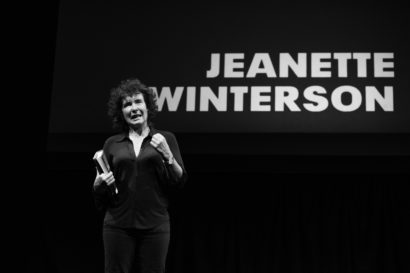 MLF Chapter & Verse
MLF Chapter & Verse
The Manchester Literature Festival Blog
Review: Jeanette Winterson: Frankissstein
Centre for New Writing student Georgia Hase finds Jeanette Winterson electrifying.
On the evening of Saturday the 5th of October Jeanette Winterson gave a reading unlike any other. Interactive, dramatic, futuristic, her performance was electrifying. Winterson animated the audience with her insightful and humorous observations which are given life in Frankissstein’s pages. Through sound effects and smoke, echoing the gothic mother text Frankenstein, and recorded dialogue Winterson gave a performance that was more theatre than reading.
The tone of the event was set before Winterson even took to the stage. Her arrival was preceded by a compilation of videos, from the many visual representations of Frankenstein and his monster, to clips of robotics and AI. These clips show how Winterson’s book Frankissstein, like the pieced together body of Frankenstein’s monster, is an amalgamation of the past, present and future. Frankissstein deals in the now of machine learning and sex-bots, whilst simultaneously looking back to the past of Shelley’s Frankenstein, and the future of AI. Mary Shelley’s Frankenstein is more than just the inspiration of Winterson’s story, it is a message in a bottle, a rope across time. Winterson firmly believes that our generation, with our advanced technology of robotics and rapidly transforming AI, are the first generation to be able to read Shelley’s Frankenstein as it should be read. Once you realise that the narrative of a creature born from electricity, unnamed and un-educated, has such startling parallels to the data training we give to our machines, it is impossible not to read Shelley’s Frankenstein with new, clearer, eyes. You may be wondering; how can our machines be un-educated when their processing capabilities far out strip our own? For Winterson, the failure to educate machines properly comes in the form of bias, more specifically, gender bias. Our machines function through data training and processing, however women are often, in Winterson’s words: “seen as smaller men, or not at all.” What this means is that our rapidly nearing future could create a negative platform for the women who have been systemically underrepresented in the data being used. It is in this world, our world, that Frankissstein is set.
Within her story Winterson brings Mary Shelley, Lord Byron, and the others who were present at Lake Geneva when the story of Frankenstein was first conceived, into the future, into the now. Mary Shelley becomes Ry Shelley, a transgender doctor who lives with “doubleness”. They (Ry’s preferred pronoun), has had top surgery but retained the female genitals they were born with. They are liminal, in-between the binaries of male and female. When asked why Winterson reimagined Mary Shelley in this way, Winterson responded that in creating this story she had had to move Mary Shelley through a mirror, so why would she not have a body that’s changed? After all, the body is approximate, not final, we see this all the time through plastic surgery, transplants and prosthetics.
This liminal ever-changing space, this doubleness, defined the reading that Winterson gave the RNCM Theatre. Whilst the future of robotics and AI could have many complications for the female gender, through under-representation and the potentiality of sex-bots making them ‘obsolete’, Winterson’s Frankissstein also reveals how the future could be freer, better, more accepting. Victor Stein (Winterson’s reimagined Victor Frankenstein) insists that the future of AI will be label free, and that Ry is just “future-early”. Ry Shelley’s doubleness embodies this hopeful possibility of a future with no genders, no classes and no races. This doubleness of hope and horror is the dichotomy that underpins both Frankenstein and Frankissstein, what future will we create when homo sapiens are no longer the smartest beings on the planet?
The Q & A section that followed Winterson’s performance, because it can only be described as a performance, seemed to focus on ‘if’ this robotic future will ever actually be achieved. Winterson made clear that she is not predicting the future with Frankissstein she is dealing with the present. Machine learning is now, sex-bots are now, companies like Amazon and Google and Facebook are working on AI privately; the general populace have no idea of how far or little they have come. Winterson believes it is not a matter of ‘if’ but when the game-changing moment of a machine being able to think for itself will happen. The subject of consciousness has been widely debated across disciplines, and in all the research that has been done, no single component of ‘consciousness’ has been found in the human body. So, why should consciousness be obliged to materiality?
Winterson’s evening of doubleness, of the dual potentiality of horror and hope, was shown in how she finished her reading and how she finished the Q & A’s. She ended her reading with Ry Shelley, who is watching people whose faces are “light by phone light, atomised and alone”. By ending the reading with this stark image of the alienating capabilities of technology, the audience was left with an uneasy feeling about the future. But this was exactly the point. Winterson concluded the Q & A’s by saying we are not living on Mars yet, get involved in the conversation, remain optimistic, remain informed and, above all, if you have daughters, teach them to code.
